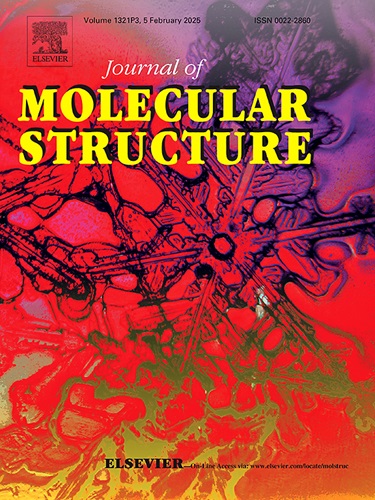Topological Co(II)-malonate polymorph: Degradation properties of Naproxen and colorimetric recognition of acetone, Cr2O72−, and Fe3+
IF 4
2区 化学
Q2 CHEMISTRY, PHYSICAL
引用次数: 0
Abstract
Two Co(II)coordination polymers namely, [Co(mal)(4,4`-bpy)0.5 (H2O)]n(1) and [Co(mal)(4,4`-bpy)0.5 (H2O)]n(2)are synthesized at ambient temperature, both complexes are based on {Co(RCOO)2}unitserving as 3D network along with sqc and fes topology and corroborated by many analytical techniques. CPs(1) crystallized in a 2D manner and then constructed a 3D hydrogen bonding network which was demonstrated monoclinic crystal system while(2)is a 3D supramolecular network that possesses a tetrahedral crystal system, according to topological analysis CPs(1) shows 5-C net and CPs(2) elaborates a 3-C net which proves both are completely different. A luminescence investigation was performed using both coordination polymers (CPs), which demonstrated effective colorimetric detection of acetone, Cr₂O₇²⁻, and Fe³⁺, with corresponding detection limits of 1.91, 2.57, and 0.29 ppm, respectively, in an ethanolic medium. Additionally, the catalytic degradation of Naproxen was evaluated for both catalysts, revealing significant degradation efficiencies of 90 % for catalyst (1) and 38 % for catalyst (2).
拓扑钴(II)-丙二酸多晶体:萘普生的降解特性以及丙酮、Cr2O72- 和 Fe3+ 的比色识别
在常温下合成了两种钴(II)配位聚合物,即[Co(mal)(4,4`-bpy)0.5 (H2O)]n(1)和[Co(mal)(4,4`-bpy)0.5 (H2O)]n(2),这两种配合物都以{Co(RCOO)2}单元为基础,具有三维网络以及sqc和fes拓扑结构,并得到了许多分析技术的证实。CPs(1) 以二维方式结晶,然后构建了三维氢键网络,显示出单斜晶系,而 CPs(2) 则是三维超分子网络,具有四面体晶系,根据拓扑分析,CPs(1) 显示出 5-C 网,而 CPs(2) 则阐述了 3-C 网,这证明两者完全不同。使用这两种配位聚合物(CPs)进行了发光研究,结果表明,在乙醇介质中,丙酮、Cr₂O₇²- 和 Fe³⁺ 的比色检测效果显著,相应的检测限分别为 1.91、2.57 和 0.29 ppm。此外,还对两种催化剂催化降解萘普生的效果进行了评估,结果显示催化剂(1)和催化剂(2)的降解效率分别为 90% 和 38%。
本文章由计算机程序翻译,如有差异,请以英文原文为准。
求助全文
约1分钟内获得全文
求助全文
来源期刊

Journal of Molecular Structure
化学-物理化学
CiteScore
7.10
自引率
15.80%
发文量
2384
审稿时长
45 days
期刊介绍:
The Journal of Molecular Structure is dedicated to the publication of full-length articles and review papers, providing important new structural information on all types of chemical species including:
• Stable and unstable molecules in all types of environments (vapour, molecular beam, liquid, solution, liquid crystal, solid state, matrix-isolated, surface-absorbed etc.)
• Chemical intermediates
• Molecules in excited states
• Biological molecules
• Polymers.
The methods used may include any combination of spectroscopic and non-spectroscopic techniques, for example:
• Infrared spectroscopy (mid, far, near)
• Raman spectroscopy and non-linear Raman methods (CARS, etc.)
• Electronic absorption spectroscopy
• Optical rotatory dispersion and circular dichroism
• Fluorescence and phosphorescence techniques
• Electron spectroscopies (PES, XPS), EXAFS, etc.
• Microwave spectroscopy
• Electron diffraction
• NMR and ESR spectroscopies
• Mössbauer spectroscopy
• X-ray crystallography
• Charge Density Analyses
• Computational Studies (supplementing experimental methods)
We encourage publications combining theoretical and experimental approaches. The structural insights gained by the studies should be correlated with the properties, activity and/ or reactivity of the molecule under investigation and the relevance of this molecule and its implications should be discussed.
 求助内容:
求助内容: 应助结果提醒方式:
应助结果提醒方式:


